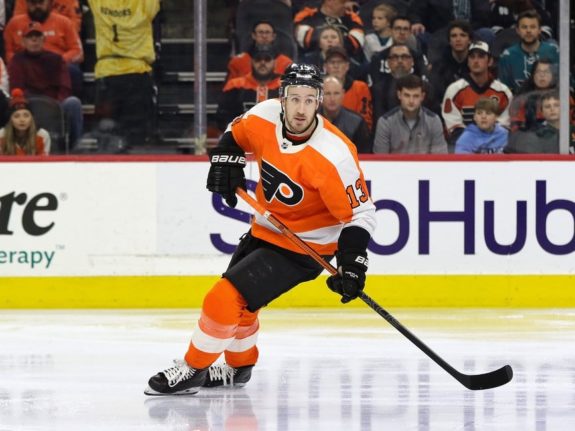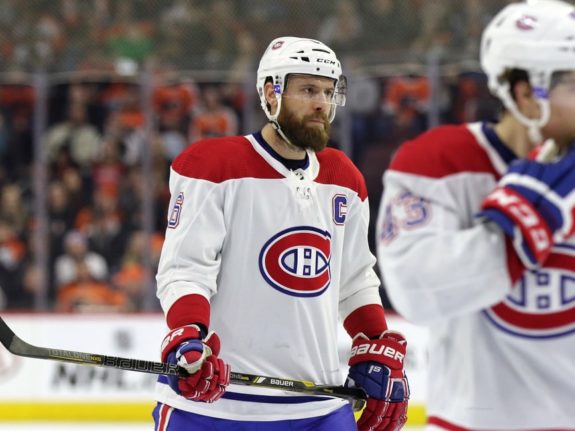The Philadelphia Flyers will begin the 2021-22 season on Friday, Oct. 15. Head coach Alain Vigneault’s club allowed more goals than any NHL team during last year’s regular season, and they will set out to improve defensively in hopes to return to the Stanley Cup Playoffs. Their struggling penalty kill (PK) was a key factor in their defensive woes. They allowed the most power-play goals in the NHL, and their PK unit finished 30th overall with a 73.1% kill rate.
Flyers Struggle on the Penalty Kill
Over five seasons from 2014-19, the Flyers’ PK unit ranked 20th or lower in the NHL. When Vigneault began in Philadelphia ahead of the 2019-20 season, he moved assistant Ian Laperrière off PK duties. He assigned Mike Yeo, former St. Louis Blues and Minnesota Wild head coach, to reverse the long-standing deficiency.

The Flyers were among the best in the NHL on the kill for most of the 2019-20 season. They dropped to 11th overall with a short slump in the final games leading up to the pause in March 2020. The addition of center Kevin Hayes ignited the unit’s energy. He finished with four shorthanded goals (SHG), and demonstrated tremendous puck control and an ability to use his long, 6-foot-5 reach to disrupt opposing power plays.
Related: Philadelphia Flyers 2021-22 Season Preview Section
They regressed significantly in 2020-21. Star players like Mika Zibanejad of the New York Rangers, Alexander Ovechkin of the Washington Capitals, and David Pastrnak of the Boston Bruins had their way with a sloppy PK. It became increasingly apparent that Hayes was battling an injury, and Scott Laughton also struggled with physical conditioning after dealing with COVID-19 in February. The Flyers used standouts Sean Couturier and Claude Giroux on the PK more frequently than they would’ve liked out of necessity. They didn’t score their first SHG until after they were already eliminated from playoff contention.
Flyers Look for Improvement in 2021-22
General manager Chuck Fletcher focused his offseason on fixing the defensive shortcomings of the 2020-21 Flyers. Key additions Ryan Ellis and Cam Atkinson will play significant shorthanded minutes, while Ellis and former teammate Matthias Ekholm were the two most frequently used defensemen on the kill for the Nashville Predators last season. Ivan Provorov, his expected partner on the first unit, finished in the top 10 among NHL defensemen in total shorthanded time on ice. Atkinson has scored 12 shorthanded goals over the past five seasons, tied for most in the NHL.

Winger Oskar Lindblom struggled during the 2020-21 season after undergoing chemotherapy treatments the year prior. The Flyers hope that he and Laughton, two of their top penalty-killing forwards, will be in stronger physical condition this season. Hayes will miss the beginning of the season recovering from abdominal surgery, but Vigneault will expect him to play significant shorthanded minutes once he returns. Veteran center Nate Thompson will also play on the PK.
Related: 5 Bold Flyers Predictions for the 2021-22 Season
The new-look PK did not achieve instant chemistry during the preseason, as the Flyers allowed eight power-play goals in six exhibition games. Jason Myrtetus mentioned on the Flyers Daily podcast that they showed a “lack of commitment on how to play oppositions’ power plays.” Bill Meltzer added that they will need to improve on “denying entries and strong side pressure” to help the goaltenders see the puck. Both acknowledged preseason performance as an initial indicator that does not represent a significant sample size.
Penalty Killing Around the NHL
The best teams in the NHL succeeded on the PK in 2020-21. The West Division champion Vegas Golden Knights finished with the best kill rate in the league at 86.9%. The Stanley Cup champion Tampa Bay Lightning finished fourth, and the East Division champion New York Islanders finished sixth.
The North Division champion Montreal Canadiens were fortunate to squeak into the playoffs. They finished 23rd on the PK during the regular season, but they were superb during the postseason. They neutralized high-powered opposing power plays with a 91.8% kill rate on their way to a berth in the Stanley Cup Final. They demonstrated an ability to adjust to the heightened intensity of playoff hockey in which penalties are bound to occur.

The Flyers clearly recognized their areas of weakness in comparison to the elite teams of the NHL. Their struggles on the PK played a major factor in their decisions to acquire Ellis, Atkinson, and defenseman Rasmus Ristolainen. They also signed Laughton to a five-year extension in April and traded away Jakub Voracek, a top-six forward who didn’t contribute to the PK, in the deal for Atkinson.
Flyers X-Factors: Goaltending and Grit
Goaltending performance can change the perception of any PK unit. The Flyers’ season will heavily depend on a rebound effort from Carter Hart in net. His issues last season were due to a combination of poor defensive play in front of him, lack of practice time and other struggles of the pandemic, and his own shortcomings in the crease. He showed acrobatic ability on the PK and a strong overall game during his first two NHL seasons and the 2020 Playoffs.
Playing a man (or two) down against opponents’ top offensive skill players is one of the hardest things NHL players are asked to do. The best PK units usually consist of players willing to take on a gritty mentality and play with heightened intensity to block shots, disrupt passing lanes, and resort to whatever necessary measures to keep the puck out of the net. The ineffective Flyers PK was a microcosm of their lack of chemistry, inability to dictate physical play, and defensive struggles in 2020-21. The unit’s ability to improve will be a key factor in the overall bounceback effort in 2021-22.